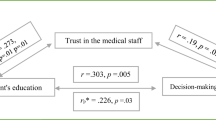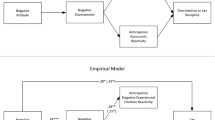Abstract
A questionnaire was developed to assess the use of disciplinary methods by parents regarding their children's approach to fearful situations. The predictive validity of this tool was evaluated by correlational analyses with the assessment of fear (behavioral, subjective, and physiological) in their children during hospitalizations for surgery. The results confirmed the usefulness of the questionnaire. Parents who reported use of positive reinforcement, modeling, and persuasion as ways of encouraging the child to deal with fearful situations had children who were low in anxiety during the actual stressful life experience. The reported use of punishment, force, or reinforcement of dependency was correlated with higher anxiety. Differences in the use of these methods by mothers and fathers are reported. The reliability of the questionnaire and its relationship to social desirability and the sex of the child are discussed.
Similar content being viewed by others
References
Baldwin, A. L. The effects of home environment on nursery school behavior.Child Development 1949,20 49–61.
Bandura, A.Social learning and personality development. New York: Holt, Rinehart & Winston, 1969a.
Bandura, A.Principles of behavior modification. New York: Holt, Rinehart & Winston, 1969b.
Bandura, A., & Walters, R. H.Adolescent aggression. New York: Ronald, 1959.
Bandura, A., Blanchard, E. B., & Ritter, B. The relative efficacy of desensitization and modeling approaches for inducing behavioral, affective, and attitudinal changes.Journal of Personality and Social Psychology 1969,13 173–199.
Baum, M. Extinction of an avoidance response in rats via response prevention (flooding): A test for residual fear.Psychological Reports 1971,28 203–208.
Baumrind, D. Child care practices anteceding three patterns of preschool behavior.Genetic Psychology Monographs 1967,75 43–88.
Baumrind, D. Socialization and instrumental competence in young children.Young Child 1970,26 104–119.
Baumrind, D. Current patterns of parental authority.Developmental Psychology Monographs 1971,4 99–103.
Bayley, N., & Schaefer, E. S. Maternal behavior and personality development data from the Berkeley growth study.Psychiatric Research Report 1960,13 155–173.
Becker, W. C. Consequences of different kinds of parental discipline. In M. L. Hoffman & L. W. Hoffman (Eds.),Review of child development research. New York: Russel Sage, 1964, pp. 169–208.
Berg, I. A., & Bass, B. M. (Eds.).Conformity and deviation. New York: Harper, 1961.
Biderman, A. D., & Zimmer, H. (Eds.).The manipulation of human behavior. New York: Wiley, 1961.
Biller, H. B., & Davids, A. Parent-child relations, personality development, and psychopathology. In A. Davids (Ed.),Abnormal child psychology. Belmont, California: Brooks-Cole, 1973, pp. 48–76.
Boulougouris, J. C., Marks, L. M., & Marset, P. Superiority of flooding (implosive) to desensitization for reducing pathological fear.Behaviour Research and Therapy 1971,9 7–16.
Carlson, N. J., & Black, A. H. Traumatic avoidance learning: Note on the effect of response prevention during extinction.Psychological Reports 1959,5 409–412.
Castaneda, A., McCandless, B. R., & Palermo, D. S. The children's form of the Manifest Anxiety Scale.Child Development 1956,27 317–326.
Cattell, R. B., & Scheier, I. H.The meaning and measurement of neuroticism and anxiety. New York: Ronald Press, 1961.
Crowne, D. P., & Marlow, D. A new scale of social desirability independent of psychopathology.Journal of Consulting Psychology 1960,24 349–354.
Estes, W. K. An experimental study of punishment.Psychological Monographs, 1944,57(3, Whole No. 263).
Ferguson, L. R.Personality Development Belmont, California: Brooks-Cole, 1970.
Fleece, L. Contingency management as a method of reducing children's disruptive behavior during dental treatment. Ph.D. dissertation, Case Western Reserve University, Cleveland, January 1979.
Geer, J. H. The development of a scale to measure fear.Behaviour Research and Therapy 1965,3 45–53.
Gewirtz, J. L. Levels of conceptual analysis in environment-infant interaction research.Merrill-Palmer Quarterly 1969,15 7–48.
Hagman, R. R. A study of fears of children of preschool age.Journal of Experimental Education 1932,1 110–130.
Heathers, G. Emotional dependence and independency in a physical threat situation.Child Development 1953,24 169–179.
Jersild, A., & Holmes, F. B. Methods of overcoming children's fears.Journal of Psychology 1935,1 75–104.
Jersild, A. T., Markey, F. U., & Jersild, C. L. Children's fears, dreams, wishes, daydreams, likes, dislikes, pleasant and unpleasant memories.Child Development Monographs, 1933, No. 12.
Johnson, R., & Dabbs, J. M. Enumeration of active sweat glands: A simple physiological indicator of psychological changes.Nursing Research 1967,16 273–276.
Jones, M. C. The elimination of children's fears.Journal of Experimental Psychology 1924,7 382–390.
Kagan, J. Acquisition and significance of sex-typing and sex-role identity. In M. L. Hoffman & L. W. Hoffman (Eds.),Review of child development research (Vol. I). New York: Russell Sage Foundation, 1964, pp. 136–167.
Kagan, J., & Moss, H. A.Birth to maturity. New York: Wiley, 1962.
Koppitz, E. M. Emotional indicators of human figure drawings in children: A validation study.Journal of Clinical Psychology 1966,22, 313–315.
Lang, P. J. Fear reduction and fear behavior problems in treating a construct. In J. M. Schien (Ed.),Research in psychotherapy (Vol. 3). Washington, D.C.: American Psychological Association, 1965.
Lang, P. J. The mechanics of desensitization and the laboratory study of human fear. In C. M. Franks (Ed.),Assessment and status of the behaviour therapies. New York: McGraw-Hill, 1968.
Lang, P. J., Melamed, B. G., and hart, J. Psychophysiological analysis of fear modification using an automated desensitization procedure.Journal of Abnormal Psychology 1970,76 220–234.
Marks, I. M.Fears and phobias. New York: Academic Press, 1969.
Martin, B., & Sroufe, L. A. Anxiety. In C. G. Costello (Ed.),Symptoms of psychopathology. New York: Wiley, 1970, pp. 216–259.
Melamed, B. G., & Siegel, L. J. Reduction of anxiety of children facing hospitalization and surgery by use of filmed modeling.Journal of Consulting and Clinical Psychology, 1975,6 31–35.
Melamed, B. G., Hawes, R. R., Heiby, E., & Glick, J. The use of filmed modeling to reduce uncooperative behavior of children during dental treatment.Journal of Dental Research 1975a,54 797–801.
Melamed, B. G., Weinstein, D., Hawes, R. R., & Katin-Borland, M. Reduction of fear-related dental management problems with use of filmed modelingJournal of the American Dental Association, 1975b,90 822–826.
Nelson, E. A. The effects of reward and punishment on subsequent dependency. Unpublished manuscript, Stanford University, 1960.
Patterson, G. R. A learning theory approach to the treatment of the school phobic child. In L. P. Ulmann & L. Krasner (Eds.),Case studies in behavior modification. New York: Holt, Rinehart & Winston, 1965.
Peterson, D. R. Behavior problems in middle childhood.Journal of Consulting Psychology 1961,25 205–209.
Peterson, D. R., Becker, W. C., Shoemaker, D. J., Luria, Z., & Hellmer, L. A. Child behavior problems and parental attitudes.Child Development 1961,32 151–162.
Pratt, K. C. A study of the “fears” of rural children.Journal of Genetic Psychology 1945,67 179–194.
Premack, D. Reinforcement theory. In D. Levine (Ed.),Nebraska symposium on motivation: 1965. Lincoln: University of Nebraska Press, 1965, pp. 123–180.
Quay, H. C., & Quay, L. C. Behavior problems in early adolescence.Child Development 1965,36 215–220.
Ritter, B. The group treatment of children's snaked phobias, using vicarious and contact desensitization procedures.Behaviour Research and Therapy 1968,6 1–6.
Ritter, B. The use of contact desensitization, demonstration-plus-participation, and demonstration alone in the treatment of acrophobia.Behaviour Research and Therapy 1969,7 157–164.
Schaefer, E. S. A circumplex model for maternal behavior.Journal of Abnormal and Social Psychology 1959,59 226–235.
Scherer, M. W., Nakamura, C. Y. A fear survey schedule for children (FSS-FC): A factor analtyic comparison with manifest anxiety (CMAS).Behaviour Research and Therapy, 1968, 173–182.
Sears, R. R., Macoby, E. E., & Levin, H.Patterns of child rearing. Evanston, Ill.: Row, Peterson, 1957.
Skinner, B. F.Science and human behavior. New York: Macmillan, 1953.
Spielberger, C. D. Theory and research on anxiety. In C. D. Spielberger (Ed.),Anxiety and behavior. New York: Academic Press, 1966, pp. 3–20.
Stampfl, T. G., & Lewis, D. J. Essentials of implosive therapy: A learning-theory-based psychodynamic behavioral therapy.Journal of Abnormal Psychology 1967,72 496–503.
Thomson, M. L., & Sutarman. The identification and enumeration of active sweat glands in man from plastic impressions of the skin.Transactions of the Royal Society of Topical Medicine and Hygiene 1953,47 412–417.
Tiller, P. O. Father-absence and personality development of children in sailor families.Nordisk Psykologis Monograph Series 1958,9 1–48.
Walton, D., & Mather, M. D. The relevance of generalization techniques to the treatment of stammering and phobic symptoms.Behaviour Research and Therapy 1963,1 121–125.
Wirt, R. D., & Broen, W. E.Booklet for the Personality Inventory for Children. Minneapolis: Authors, 1958.
Venham, L. L., Murray, P., & Gaulin-Kremer, E. Child-rearing variables affecting the preschool child's response to dental stress.Journal of Dental Research, 1979,58 2042–2045.
Author information
Authors and Affiliations
Rights and permissions
About this article
Cite this article
Zabin, M.A., Melamed, B.G. Relationship between parental discipline and children's ability to cope with stress. Journal of Behavioral Assessment 2, 17–38 (1980). https://doi.org/10.1007/BF01321430
Accepted:
Issue Date:
DOI: https://doi.org/10.1007/BF01321430




